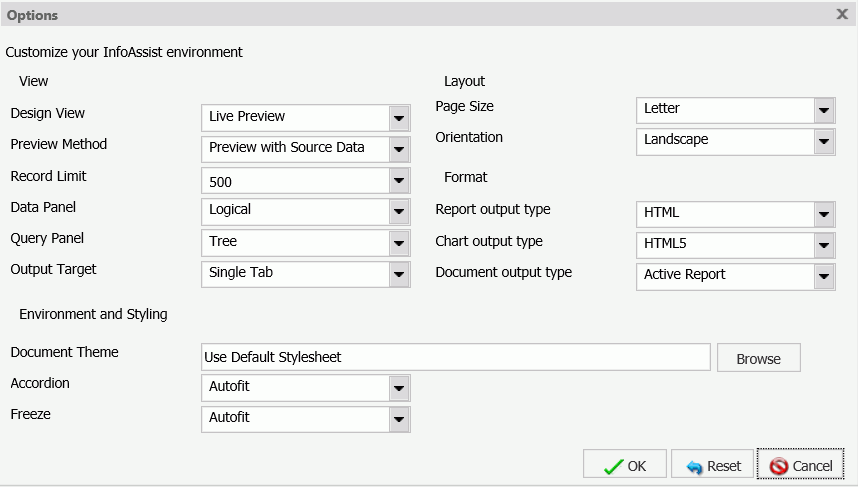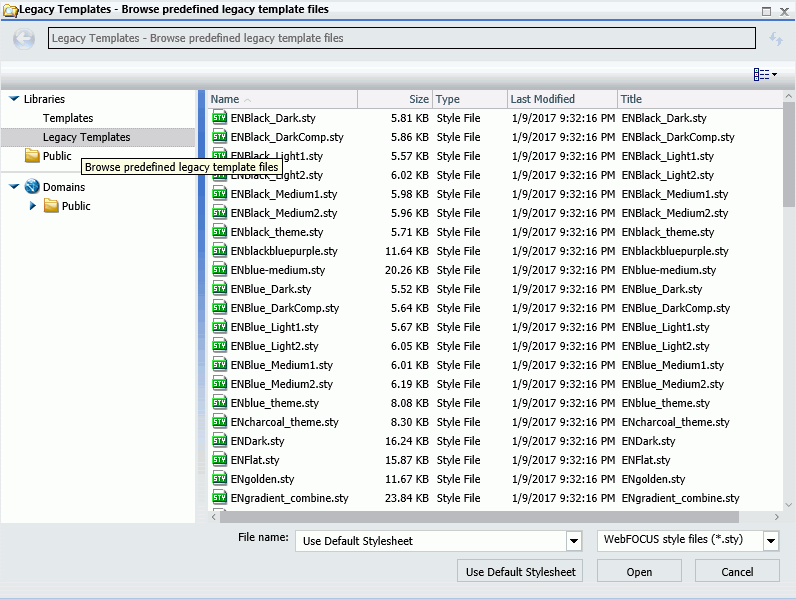Changing InfoAssist User Preferences
|
Topics: |
You can change the default user preferences to customize the way that InfoAssist behaves when you create reports and generate output. The application theme, which is inherited from the portal, customizes the InfoAssist interface, including all menus and dialog boxes.
You can style your reports by selecting a document theme independent from the interface. On the InfoAssist application main menu, click Options.
The Options window, as shown in the following image, opens to provide you with a user-friendly interface for customizing the InfoAssist application.

Note: If you make changes to the default selections in the Options dialog box, changes will take effect the next time InfoAssist launches.
If any of the options are unavailable, contact your administrator for assistance.
View
The View area provides settings for establishing the design view in which you will work, the type of data you will use when you preview your output, the limit you need to set on your record input, how your data and query panels will look, and the output target that you will use.
- Design View. Values are Live Preview and Query. Select Live Preview to activate the Preview Method drop-down menu. The default value is Live Preview.
- Preview Method. Values are Preview with Source Data and Preview with Sample Data. This menu becomes active when you select Live Preview from the Design View drop-down menu. The default value is Preview with Source Data.
- Record Limit. Values are All records, 1, 10, 50, 500, or you can type a numeric value directly in the menu. The default value is 500.
- Data Panel. Values are Logical, List, and Structured. The default value is Logical.
- Query Panel. Values are 2x2 (2 columns by 2 rows), 1x4 (1 column by 4 rows), and Tree. The default value is Tree.
- Output Target. Values are Single Tab, New Tab, Single Window, and New Window. The default value is Single Tab.
Layout
The Layout area provides settings for printing reports and charts.
- Page Size. Values are A4, A3, A5, Letter, Tabloid, and Legal. The default value is Letter.
- Orientation. Values are Portrait and Landscape. The default value is Portrait.
Format
The Format area provides settings for the output types for reports, charts, and documents.
- Report output type. Values are HTML, PDF, PowerPoint (pptx), Excel (xlsx), Excel (xlsx Formula), Excel, Excel (Formula), Excel (csv), and active report. The default value is HTML.
- Chart output type. Values are HTML, HTML5, PDF, PowerPoint (pptx), Excel (xlsx), Excel, and active report. The default value is HTML5.
- Document output type. Values are HTML, PDF, PowerPoint (pptx), Excel (xlsx), Excel (xlsx Formula), Excel, Excel (Formula), and active report. The default value is active report.
Environment and Styling
The Environment and Styling area provides settings for styling reports and charts through the specification of a Document Theme. Click the Browse button to open the Templates - Browse predefined template files dialog box, in which you can search for an existing WebFOCUS StyleSheet. The default StyleSheet is Warm.sty, but you can select from the other themes that are available (Dark.sty or Flat.sty).
Note: StyleSheets are stored in the following directory of your Business User Edition installation:
drive:\ibi\WebFOCUSBUE82\IBI_HTML\ibi_themes
In addition, you can access a repository of additional themes by accessing the Legacy Templates, under Libraries, as shown in the following image.

-
Accordion. Values for this option are: Autofit and Legacy. The enhanced Accordion report format is built to autofit and be adaptive within windows and portal page containers. The legacy Accordion report opens in a tree structure independent of the window or container. The default value is Autofit.
-
Freeze. The Freeze option allows you to define a scroll area within the data of your report. It locks the headings and footings in place, enabling you to scroll through the data within the container. Values for this option are: Autofit and Fixed. Autofit sizes the scroll bar to fit the container. Fixed sets the scroll height to the default 4" size. The default value is Autofit.
Changing Global Preferences
You can change global preferences for InfoAssist through the Administration Console found on the portal. To do so, in the Administration Console, on the Configuration tab, click InfoAssist Properties.
| WebFOCUS | |
|
Feedback |